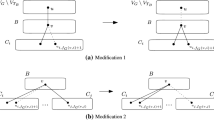Abstract
We study some counting and enumeration problems for chordal graphs, especially concerning independent sets. We first provide the following efficient algorithms for a chordal graph: (1) a linear-time algorithm for counting the number of independent sets; (2) a linear-time algorithm for counting the number of maximum independent sets; (3) a polynomial-time algorithm for counting the number of independent sets of a fixed size. With similar ideas, we show that enumeration (namely, listing) of the independent sets, the maximum independent sets, and the independent sets of a fixed size in a chordal graph can be done in constant amortized time per output. On the other hand, we prove that the following problems for a chordal graph are # P-complete: (1) counting the number of maximal independent sets; (2) counting the number of minimum maximal independent sets. With similar ideas, we also show that finding a minimum weighted maximal independent set in a chordal graph is NP-hard, and even hard to approximate.
Preview
Unable to display preview. Download preview PDF.
Similar content being viewed by others
References
Beeri, C., Fagin, R., Maier, D., Yannakakis, M.: On the Desirability of Acyclic Database Schemes. Journal of the ACM 30, 479–513 (1983)
Blair, J.R.S., Peyton, B.: An Introduction to Chordal Graphs and Clique Trees. In: George, A., Gilbert, J.R., Liu, J.W.H. (eds.) Graph Theory and Sparse Matrix Computation. IMA, vol. 56, pp. 1–29. Springer, Heidelberg (1993)
Brandstädt, A., Le, V.B., Spinrad, J.P.: Graph Classes: A Survey. SIAM, Philadelphia (1999)
Buneman, P.: A Characterization of Rigid Circuit Graphs. Discrete Mathematics 9, 205–212 (1974)
Chandran, L.S.: A Linear Time Algorithm for Enumerating All the Minimum and Minimal Separators of a Chordal Graph. In: Wang, J. (ed.) COCOON 2001. LNCS, vol. 2108, pp. 308–317. Springer, Heidelberg (2001)
Chandran, L.S., Ibarra, L., Ruskey, F., Sawada, J.: Generating and Characterizing the Perfect Elimination Orderings of a Chordal Graph. Theoretical Computer Science 307, 303–317 (2003)
Eppstein, D.: All Maximal Independent Sets and Dynamic Dominance for Sparse Graphs. In: Proc. 16th Ann. ACM-SIAM Symp. on Discrete Algorithms, pp. 451–459. ACM, New York (2005)
Farber, M.: Independent Domination in Chordal Graphs. Operations Research Letters 1(4), 134–138 (1982)
Flum, J., Grohe, M.: The Parameterized Complexity of Counting Problems. SIAM Journal on Computing 33(4), 892–922 (2004)
Fulkerson, D.R., Gross, O.A.: Incidence Matrices and Interval Graphs. Pacific J. Math. 15, 835–855 (1965)
Gavril, F.: Algorithms for Minimum Coloring, Maximum Clique, Minimum Covering by Cliques, and Maximum Independent Set of a Chordal Graph. SIAM Journal on Computing 1(2), 180–187 (1972)
Golumbic, M.C.: Algorithmic Graph Theory and Perfect Graphs, 2nd edn. Annals of Discrete Mathematics, vol. 57. Elsevier, Amsterdam (2004)
Klein, P.N.: Efficient Parallel Algorithms for Chordal Graphs. SIAM Journal on Computing 25(4), 797–827 (1996)
Leung, J.Y.-T.: Fast Algorithms for Generating All Maximal Independent Sets of Interval, Circular-Arc and Chordal Graphs. Journal of Algorithms 5, 22–35 (1984)
Provan, J.S., Ball, M.O.: The Complexity of Counting Cuts and of Computing the Probability that a Graph is Connected. SIAM Journal on Computing 12, 777–788 (1983)
Spinrad, J.P.: Efficient Graph Representations. American Mathematical Society, Providence (2003)
Vadhan, S.P.: The Complexity of Counting in Sparse, Regular, and Planar Graphs. SIAM Journal on Computing 31(2), 398–427 (2001)
Author information
Authors and Affiliations
Editor information
Editors and Affiliations
Rights and permissions
Copyright information
© 2005 Springer-Verlag Berlin Heidelberg
About this paper
Cite this paper
Okamoto, Y., Uno, T., Uehara, R. (2005). Linear-Time Counting Algorithms for Independent Sets in Chordal Graphs. In: Kratsch, D. (eds) Graph-Theoretic Concepts in Computer Science. WG 2005. Lecture Notes in Computer Science, vol 3787. Springer, Berlin, Heidelberg. https://doi.org/10.1007/11604686_38
Download citation
DOI: https://doi.org/10.1007/11604686_38
Publisher Name: Springer, Berlin, Heidelberg
Print ISBN: 978-3-540-31000-6
Online ISBN: 978-3-540-31468-4
eBook Packages: Computer ScienceComputer Science (R0)




